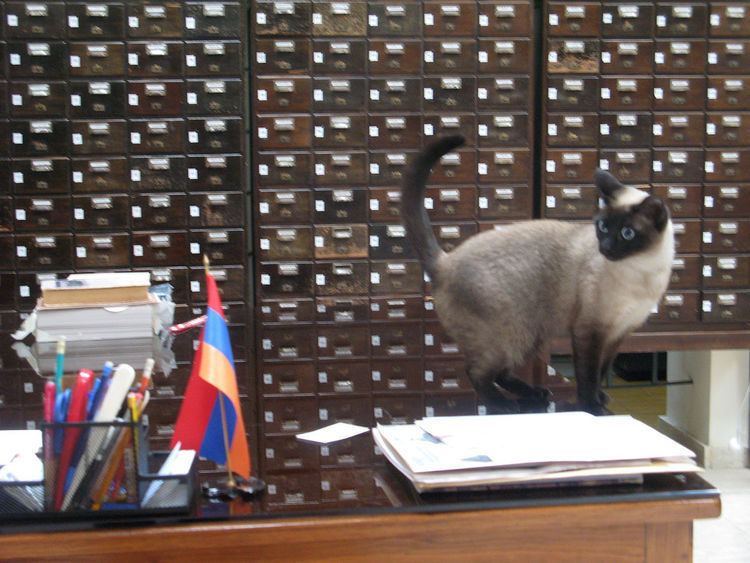 | ||
Library cats are domesticated cats that live in public libraries worldwide. The association of cats with libraries dates to antiquity, when libraries in temples of ancient Egypt had cats-in-residence for rodent control. The association continued in the Middle Ages, into the nineteenth and twentieth centuries, and up to the present day.
Contents
Contemporary library cats have also been featured in film and literature. Their presence helps create a relaxed and calming environment for patrons and staff; other roles include involvement in marketing and in reading and literacy programs.
History
The relationship between cats and libraries is centuries old. The association relates back to ancient times when Herodotus described the existence of libraries in Egyptian temples. During this period, some animals were given special training to prevent rodents and serpents from infiltrating temples in an effort to preserve papyrus rolls. Monastic records from the Middle Ages indicate cats were utilized in medieval monasteries to stop rats from eating valuable manuscripts. In 1745, Russian Empress Elisabeth published an order to transport cats to her court. The descendants of these cats now patrol the State Hermitage museum. During the nineteenth century, the British government compensated libraries housing cats that kept rodents away from books.
Modern examples
Modern day library cats have appeared as characters in books and movies, are immortalized in stone in front of their institutions, and some are given positions on the institution's board. Many cats enjoy high profile professional roles of marketing and public relations.
The relationship between libraries and cats is at times contentious. There have been attempts in one case to remove a cat from a library based upon concerns about patrons with allergies claiming violations of the Americans with Disabilities Act, and in another specific case the reaction of a cat to other service animals. In one case, the removal of a library cat from its institution in Putnam Valley, New York, harmed the institution financially, when two members of the community were so upset about the removal that they removed the library from their wills, producing an $80,000 loss in potential revenue.
The Library Cat Society, a now defunct organization, was established in 1987 to encourage the establishment, respect, and recognition of library cats. The society included dozens of member libraries that exchanged information about their cats, and published a newsletter about them.
The ongoing relationship of cats and libraries has been chronicled in the anthology Cats, Librarians, and Libraries: Essays for and About the Library Cat Society. The lives of library cats were explored by Gary Roma, a documentarian who produced a film entitled Puss in Books: Adventures of the Library Cat. According to Roma’s website, there are over 800 cataloged library cats worldwide, although the catalog indicates that many of them have since metaphorically crossed the Rainbow Bridge.
Additionally, cats can commonly be found in independent bookstores throughout the United States.
Benefits
Library cats have been used to befriend patrons, boost librarian morale, and inspire reading and literacy programs. Cats can also be useful for marketing campaigns, and are frequently used to generate publicity for their libraries, particularly on social media. The presence of a cat can create a relaxed environment and ease daily stress for patrons and librarians alike, but usually without the typically disruptive loud noises other animals (e.g. dogs) may produce. Cats' generally independent nature may also suit the intellectual environment of a library, as they are low-maintenance and may more readily suit the otherwise preoccupied intellectual personalities who frequent libraries.
Famous example
Dewey Readmore Books is perhaps the most famous library cat. He lived in Iowa’s Spencer Public Library for 19 years. After his death, a book was published about him, and later a number of followup books.
